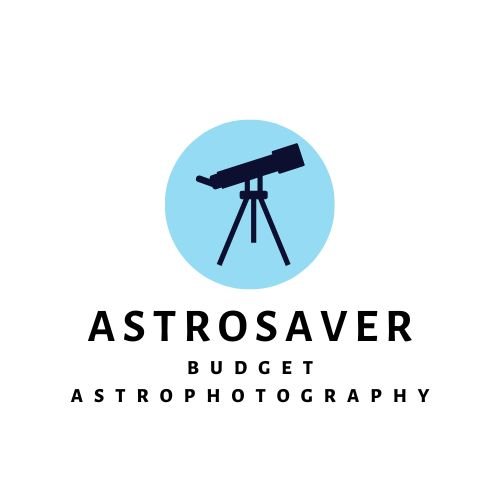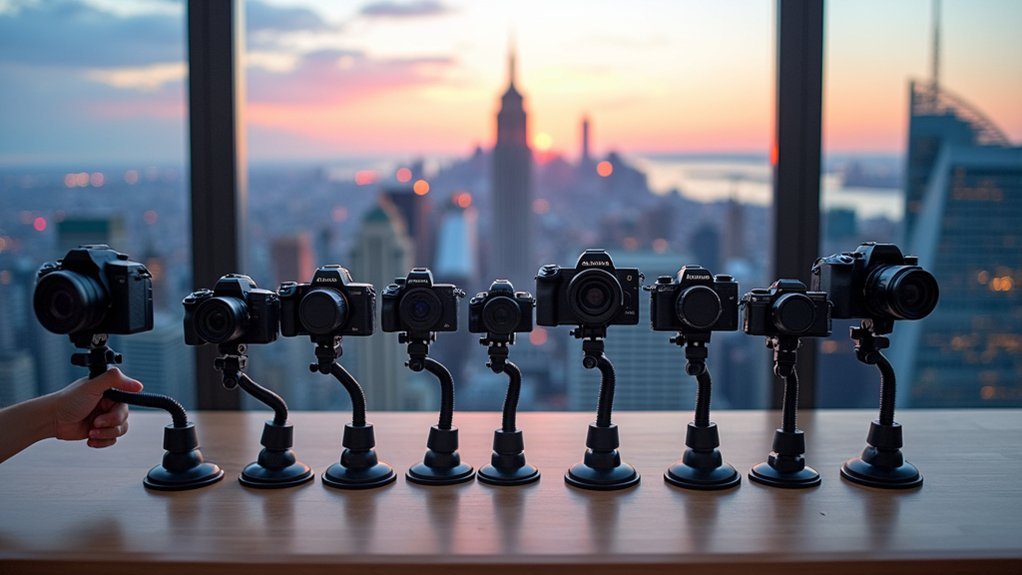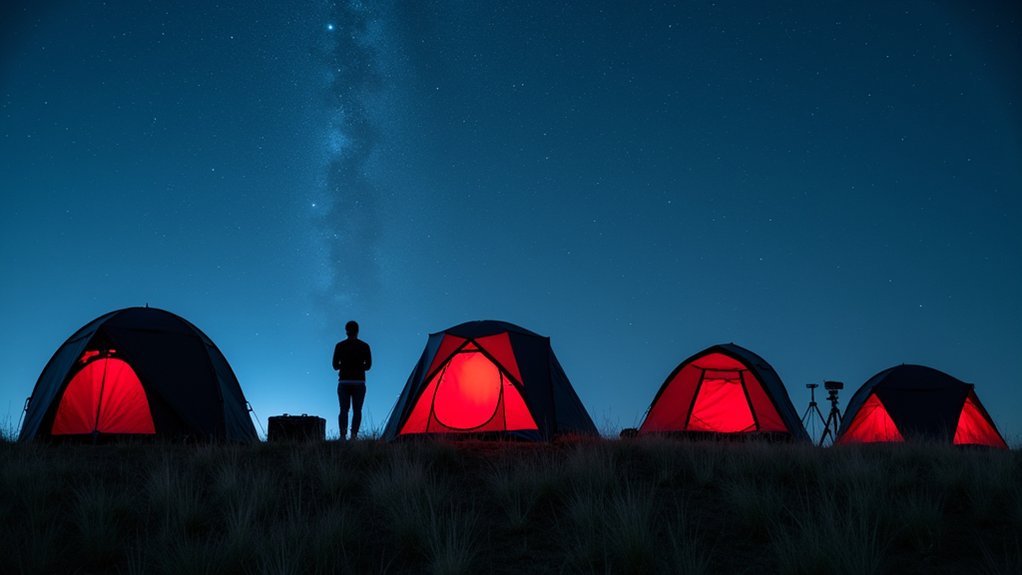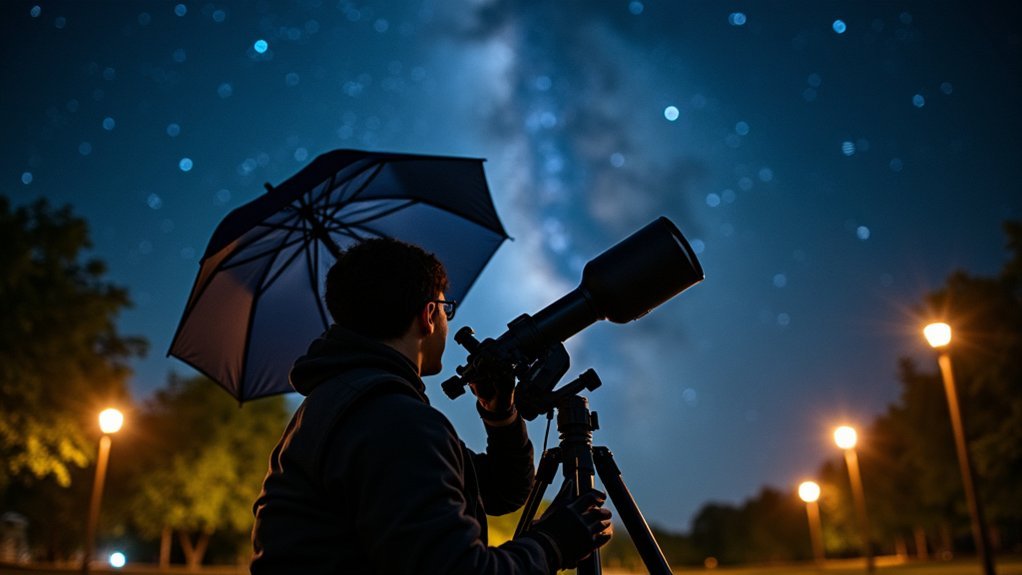Astrophotography stacking software transforms your cosmic images by combining multiple exposures to reduce noise and enhance details. Popular options include free programs like DeepSkyStacker, Siril, and AutoStakkert!, while premium solutions like PixInsight ($240) offer extensive calibration tools. Sequator excels at wide-field Milky Way shots, while RegiStax specializes in planetary detail enhancement. Your choice depends on your target objects, budget, and experience level. The right software will dramatically elevate your celestial photography results.
Top 10 Image Stacking Software for Astro Photos

Five leading programs dominate the astrophotography stacking landscape, each offering unique capabilities for different skill levels and imaging targets.
DeepSkyStacker stands out for beginners with its user-friendly interface and excellent noise reduction capabilities—all for free.
If you’re ready to invest, PixInsight ($240) provides extensive calibration tools, though you’ll face a steeper learning curve.
Budget-conscious photographers should consider Siril, an open-source alternative supporting multiple file formats and advanced processing techniques.
For planetary imaging, Autostakkert! excels with its automatic alignment algorithms that select only the best frames from video captures.
Meanwhile, Astro Pixel Processor ($175) offers an intuitive workflow with specialized features for mosaic creation and star color calibration.
Your choice ultimately depends on your target objects, budget constraints, and technical comfort level.
DeepSkyStacker: The Beginner’s Gateway to Astrophotography
Among the stellar options mentioned above, DeepSkyStacker emerges as the perfect starting point for anyone new to astrophotography. This free stacking software offers a user-friendly interface that won’t overwhelm you as you learn the ropes.
You’ll appreciate how DeepSkyStacker automatically aligns and stacks your astrophotography images, compensating for minor tracking errors. Its powerful noise reduction capabilities greatly improve the signal-to-noise ratio, revealing details that single exposures miss.
The software supports various image formats and lets you incorporate calibration frames (dark, bias, and flat frames) to enhance your final images.
When you encounter challenges, you’ll find the active user community invaluable, with numerous tutorials and forums to guide your progress.
DeepSkyStacker’s alignment and stacking features deliver professional-quality results without the complexity of more advanced tools.
Pixinsight: Professional-Grade Stacking With Advanced Features

PixInsight’s exceptional processing workflow stands out with its extensive toolset that you’ll master as you progress from basic calibration to advanced compositing techniques.
You’ll appreciate how the software’s sophisticated algorithms dramatically reduce noise while preserving vital details in your deep-sky photographs.
The multithreaded capabilities guarantee you’re not waiting around during resource-intensive stacking operations, allowing for a more efficient editing experience even with large batches of astrophotography data.
Processing Workflow Excellence
While many stacking programs offer basic functionality, PixInsight stands apart as a thorough powerhouse for serious astrophotographers. Its advanced features enable extensive workflow management from calibration through final editing, with powerful algorithms handling everything from noise reduction to color calibration.
You’ll appreciate PixInsight’s workflow advantages through:
- Multithreaded processing tools that maximize your computer’s resources for faster stacking of large image sets.
- Automated scripts for streamlining repetitive tasks and creating consistent results.
- Dynamic background extraction and histogram equalization for dramatic improvement in image quality.
- Extensive file format support including FITS, allowing seamless integration with other astrophotography equipment.
Though the learning curve is steep, the active user community provides abundant resources to help master this professional-grade stacking workflow.
Extraordinary Noise Reduction
Noise represents the greatest enemy of stunning astrophotography, and PixInsight tackles this challenge with extraordinary capabilities.
Its advanced noise reduction algorithms dramatically enhance the signal-to-noise ratio in your astro images, revealing details previously hidden in the noise floor.
When you’re processing deep-sky objects, PixInsight’s sophisticated calibration tools let you incorporate dark, bias, and flat frames to efficiently remove artifacts that plague astrophotos.
The stacking software leverages multithreaded processing to handle massive image sets while maintaining precise alignment between frames.
Though you’ll face a steep learning curve, advanced users consistently choose PixInsight for its uncompromising results.
Your final images will exhibit remarkably clean backgrounds and preserved detail—benefits that justify the investment in mastering this professional-grade platform’s powerful workflow.
Sequator: Budget-Friendly Solution for Wide-Field Nightscapes
Sequator’s intuitive tracking interface makes aligning stars straightforward, even if you’re new to astrophotography.
You’ll appreciate its compatibility with RAW files, preserving maximum detail while allowing direct import from your camera.
Beyond standard stacking, you can explore creative options like star trail modes that transform ordinary night shots into artistic celestial displays.
Simple Tracking Interface
For beginners seeking an accessible entry point into astrophotography, Sequator offers a remarkably intuitive tracking interface that won’t strain your budget.
This stacking software empowers amateur astrophotographers to align and stack deep-sky images with minimal technical knowledge.
When you use Sequator’s simple tracking interface, you’ll appreciate:
- Automated alignment that precisely matches star positions across multiple exposures
- Fast stacking capabilities that reduce processing time dramatically compared to professional alternatives
- Built-in noise reduction tools that clean up your final images without additional software
- RAW format support that preserves maximum detail from your camera’s sensor
The interface guides you through each step to achieve ideal stacking results, making this versatile tool perfect for capturing stunning Milky Way photos and wide-field nightscapes.
Compatibility With RAWs
Many budget-conscious astrophotographers appreciate Sequator’s extensive RAW format support, which stands as a cornerstone feature of this free, open-source stacking solution.
You’ll benefit from working with high-quality data captured by your DSLR or mirrorless camera, ensuring ideal stacking results for your nightscape images.
This user-friendly interface allows you to import RAW images directly, preserving all the critical details needed for effective noise reduction.
Sequator’s automatic alignment capabilities work seamlessly with these uncompressed files, properly registering stars and celestial objects even in uncalibrated frames.
The software efficiently processes your high-quality data, greatly enhancing the signal-to-noise ratio and making faint objects more visible in your final composition.
For creating stunning nightscape images without breaking the bank, Sequator delivers professional-grade astrophotography results from your RAW files.
Star Trail Options
Several specialized star trail options in Sequator transform your series of night shots into mesmerizing celestial paths across the sky.
This budget-friendly stacking software offers impressive capabilities for astrophotographers seeking to create stunning nightscapes without expensive equipment.
- Automatic alignment technology guarantees your images stack perfectly even with minor tracking errors.
- Foreground preservation allows you to include landscape elements while only stacking the sky portion.
- Noise reduction features enhance the quality of your final stacked image by eliminating unwanted artifacts.
- Fast processing through its beginner-friendly interface lets you quickly visualize your star trails without complex setups.
You’ll appreciate how Sequator makes astrophotography accessible, delivering professional-looking results that showcase both the beauty of star trails and the landscape beneath them.
Siril: Open-Source Power for Deep Sky Processing
While commercial options dominate the market, Siril stands out as a powerful open-source alternative that’s revolutionizing deep-sky astrophotography processing.
This versatile tool handles the complete workflow from calibration to final processing, delivering professional results without the premium price tag.
You’ll appreciate Siril’s automatic image registration capabilities that perfectly align your exposures, considerably reducing noise while enhancing fine details in your deep-sky images.
The user-friendly interface makes complex stacking procedures accessible, whether you’re a beginner or experienced astrophotographer.
What sets Siril apart is its compatibility with various file formats, including FITS, and its powerful scripting support that lets you automate repetitive tasks.
With regular updates driven by an active community, you’re investing in software that continuously evolves with the latest astrophotography techniques.
Astro Pixel Processor: Innovative Algorithms for Superior Results

Astro Pixel Processor (APP) has emerged as a game-changer in the astrophotography community with its revolutionary algorithms that transform raw captures into stunning celestial portraits.
For approximately €165 + VAT, you’ll gain access to high-quality image processing capabilities that rival more expensive alternatives.
APP’s strengths include:
- Advanced algorithms that streamline calibration and stacking, creating an efficient workflow for both novices and experts
- Automated essential tasks like color calibration and panorama stitching that save you valuable time
- Superior noise reduction techniques that enhance visibility of faint celestial objects
- User-friendly interface that makes complex astro photography techniques accessible to beginners
You’ll appreciate how APP’s intuitive design simplifies complex processes while delivering professional results that reveal cosmic details otherwise invisible.
AutoStakkert!: Specialized Software for Planetary Imaging
The free planetary imaging powerhouse AutoStakkert! has revolutionized how astrophotographers capture celestial neighbors like Mars, Jupiter, and Saturn. Its automatic alignment and stacking algorithms greatly enhance your final image quality by selecting only the best frames from your video formats, effectively combating atmospheric distortion.
You’ll appreciate the intuitive user interface that makes the software accessible whether you’re a beginner or experienced astrophotographer. The stacking process can be customized to your specific needs with advanced features like adjustable quality settings and batch processing capabilities.
What sets AutoStakkert! apart is its specialized focus on planetary imaging, offering tailored tools that let you fine-tune results based on your imaging conditions and project requirements.
This targeted approach delivers consistently impressive planetary photographs with remarkable detail.
ASIDeepStack: Fast Processing for ZWO Camera Users

For ZWO camera users seeking lightning-fast image stacking solutions, ASIDeepStack delivers exceptional performance as a free software integrated within ASI Studio.
This popular choice among astrophotographers processes your data in under two minutes while maintaining ease of use for beginners and experts alike.
ASIDeepStack’s advanced algorithms enhance image quality without complicating the workflow:
- Comprehensive calibration – Supports light frames, dark frames, and bias frames for complete processing
- Streamlined interface – Simple UI designed for quick learning and efficient operation
- Optimized for speed – Fast processing that respects your time and workflow
- ZWO integration – Seamlessly works with your existing ZWO camera setup for both planetary and deep-sky imaging
You’ll appreciate how this image stacking software balances powerful features with remarkable processing speeds.
ASTAP: Astrometric Precision With Plate-Solving Capabilities
When seeking both exceptional image stacking and precise astrometric data, ASTAP stands out as a powerful free solution that combines these essential functions seamlessly.
The software’s integrated plate-solving capabilities allow you to accurately determine celestial coordinates of your images, a valuable feature for serious astrophotographers.
You’ll appreciate ASTAP’s fast and precise stacking algorithms that work effectively for both deep-sky astrophotography and planetary imaging. Supporting various formats including FITS and JPEG, the program offers versatility for different workflows.
Advanced features like background calibration and sophisticated star detection markedly reduce noise in your final stacked images.
Whether you’re a beginner or experienced astrophotographer, ASTAP’s user-friendly interface makes achieving astrometric precision straightforward while maintaining efficiency throughout the stacking process.
This combination of accessibility and powerful features makes ASTAP an excellent choice.
RegiStax: Wavelet Processing for Enhanced Detail Extraction

RegiStax transforms your planetary images through its powerful wavelet processing technology, which separates details at different scales for targeted enhancement.
You’ll find that the multi-level adjustment capabilities allow you to sharpen fine stellar features while keeping noise under control—a vital balance in astrophotography.
The user-friendly interface makes applying these complex mathematical transformations intuitive, letting you progressively fine-tune each wavelet level until your celestial targets reveal their hidden details.
Wavelet Transformation Basics
Although many astrophotographers focus primarily on image stacking, wavelet transformation serves as the secret weapon that truly brings celestial details to life. This mathematical technique breaks down your image into different frequency components, allowing you to enhance details while keeping noise in images under control.
When using RegiStax’s wavelet processing features, you’ll gain precise control over your final image quality through:
- Multi-scale enhancement options that target specific astronomical features
- Selective adjustment tools that preserve important structures while helping reduce noise
- Real-time preview capabilities that enable an interactive workflow
- Variable strength controls that let you fine-tune each frequency level separately
The beauty of wavelet processing lies in its ability to reveal subtle details that would otherwise remain hidden, transforming good astrophotography into spectacular celestial portraits.
Star Detail Enhancement
Fine details hidden within your astronomical images can be dramatically revealed through RegiStax’s powerful wavelet processing tools. This leading image stacking software allows you to extract subtle features from celestial objects that might otherwise remain invisible to the casual observer.
RegiStax gives you precise control over different wavelet scales, letting you enhance specific frequency ranges to improve clarity in your astrophotography. You’ll appreciate how you can selectively manipulate wavelet coefficients for effective noise reduction while preserving critical details.
For planetary imaging, RegiStax excels at reducing atmospheric distortion and enhancing planetary textures.
Whether you’re a beginner using the intuitive interface or an experienced astrophotographer diving into advanced tools, the software’s wavelet processing capabilities will greatly elevate your star detail enhancement results without introducing unwanted artifacts.
Frequently Asked Questions
What Is the Best Stacking Software for Astrophotography?
The best stacking software depends on your experience level. If you’re a beginner, try DeepSkyStacker. For advanced control, consider PixInsight. Siril offers a free alternative, while Autostakkert! excels specifically for planetary imaging.
How to Do Image Stacking in Astrophotography?
To stack astrophotography images, you’ll need to capture multiple exposures, align them with software like DeepSkyStacker, add calibration frames to remove artifacts, then combine them to dramatically reduce noise and enhance details.
What Is the Best Astrophotography Software?
The best astrophotography software depends on your experience level. If you’re a beginner, try DeepSkyStacker for free. Advanced users should consider PixInsight, while Autostakkert! works best for planetary imaging. Siril offers a free alternative.
What Is the Best App to Stack Photos?
For general photo stacking, you’ll find DeepSkyStacker ideal if you’re a beginner. If you’re experienced, PixInsight offers extensive control. For planetary images, try Autostakkert!, while Sequator works well for nightscapes and deep-sky images.
In Summary
You’ll find the perfect stacking software depends on your specific needs and experience level. Whether you’re just starting with DeepSkyStacker or ready for PixInsight’s advanced capabilities, these tools will dramatically improve your astrophotography results. Don’t be afraid to experiment with different options—each offers unique strengths. With practice and the right software, you’ll soon transform your raw astro images into stunning cosmic portraits.





Leave a Reply